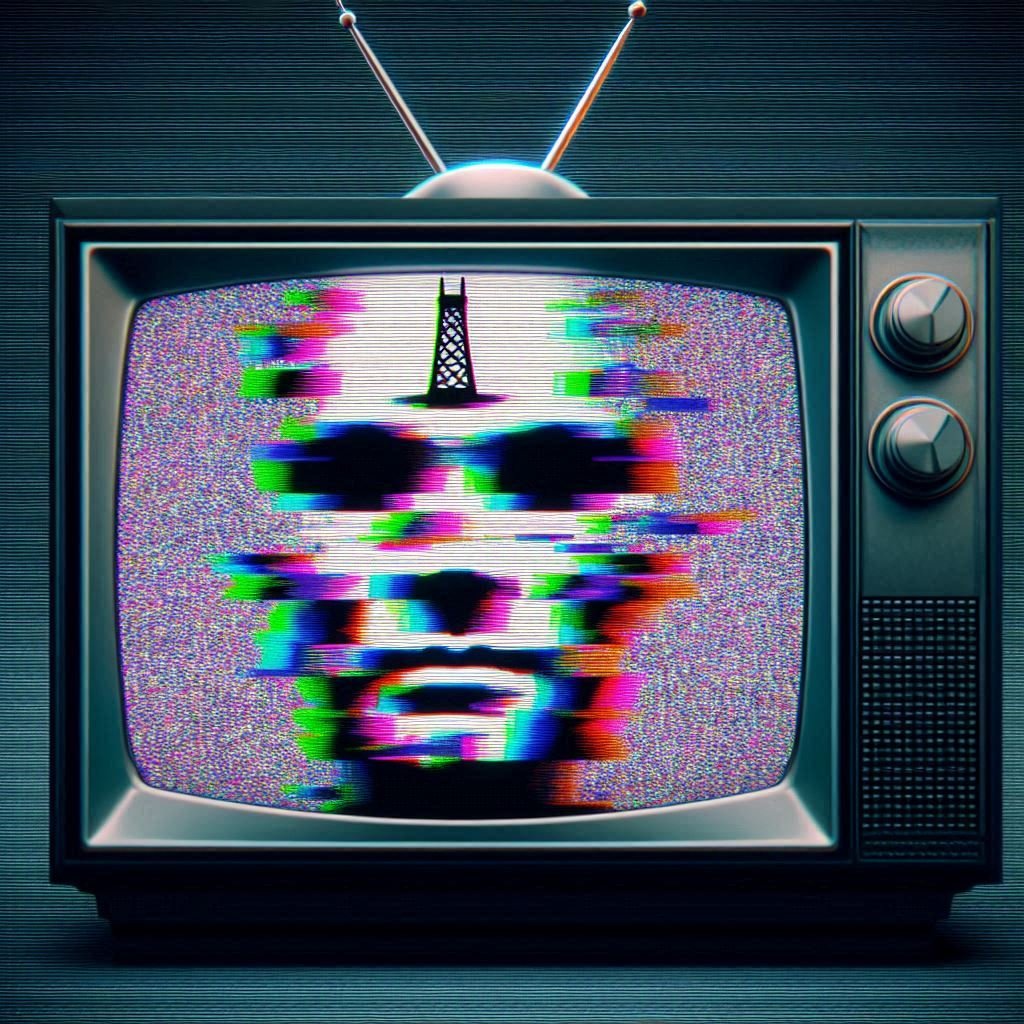Listen to “The Night TV Was Hijacked” on Spreaker.
Let me set the scene for you.
You’re sitting on the couch. It’s late on a Sunday night in the late 1980s. Maybe you’re with family, maybe you’re alone. The TV is on — the warm glow of the screen fills the living room. It’s familiar, safe. News anchors are giving the latest updates, or maybe you’ve switched over to a science fiction show to wind down the weekend. Nothing unusual.
Then, without warning… the screen flickers. Static. The sound cracks. And suddenly, your television — this thing you trust — is hijacked.
On screen is not your news anchor, not your show, but a face.
A face covered with a mask. A plastic, distorted face of a character named Max Headroom.
And whoever is behind that mask begins to speak in a garbled, unsettling voice. The figure sways erratically in front of a spinning metal background. It doesn’t look funny. It doesn’t look clever. It looks wrong.
And in that moment, you’re frozen. You don’t know if this is a joke, a technical glitch, or something much darker.
This is the story of the Max Headroom Signal Intrusion, one of the strangest unsolved mysteries in television history.
And the scariest part? To this day, nobody knows who did it.
A Normal Night in Chicago
Our story takes place on November 22, 1987, in Chicago, Illinois.
This was back when TV wasn’t just entertainment — it was the thing. Cable was growing, but most people still watched local broadcast stations. These channels were heavily regulated by the government. You weren’t supposed to be able to mess with them.
And yet, someone was about to prove otherwise.
That night, two TV stations were at the center of the story:
-
WGN-TV Channel 9, a major independent station known for sports and news.
-
WTTW Channel 11, Chicago’s PBS affiliate, loved for cultural and educational shows.
At 9 PM, WGN was airing its nightly news. Sportscaster Dan Roan was giving highlights from the Chicago Bears’ football game. On WTTW, fans of Doctor Who were tuned into the episode Horror of Fang Rock.
Everything was normal. Millions of Chicagoans were watching.
And then — without warning — came the first hijacking.
The First Attack – WGN-TV
At 9:14 PM, Dan Roan was mid-sentence, talking about the Bears’ big win.
Suddenly, the screen went haywire.
The picture dissolved into static. The sound cut into a high-pitched buzz. Then the figure appeared.
A person in a Max Headroom mask.
Now, for context: Max Headroom was a fictional character, an AI television host created in the 1980s. He was everywhere in pop culture — stuttering, glitchy, and cocky. But this wasn’t that Max Headroom. This was a cheap, distorted imitation.
The masked figure bobbed and weaved in front of a spinning piece of corrugated metal, trying to imitate the character’s signature digital background. The voice was distorted and difficult to make out, like a demonic parody.
The intrusion lasted maybe 20 seconds.
Then, just as suddenly, WGN engineers cut the signal. Dan Roan came back on screen, visibly rattled. He apologized for the “technical difficulties” and tried to continue with sports.
But for everyone at home, the damage was done. They had seen something they weren’t supposed to see. Something that felt almost… forbidden.
And what nobody knew was that this was only the beginning.
The Second Attack – WTTW
Just over two hours later, around 11:15 PM, the pirate struck again.
This time, during Doctor Who.
Fans were deep into the episode when suddenly, the screen flickered. The static returned.
And once again — Max Headroom.
But this time, it was longer. Creepier. And far more disturbing.
The masked figure swayed, speaking in that warped voice. Unlike the first interruption, some words were actually understandable. He mocked WGN, calling one anchor a “nerd.” He held up a Pepsi can and shouted “Catch the wave!” — mocking Coca-Cola’s real Max Headroom commercials. He referenced the “New World Order.”
Then, things got darker.
The figure bent over, pulled down his pants, and exposed his bare butt. An accomplice, off camera, spanked him with a fly swatter.
The voice groaned: “Oh my God… they’re coming back!”
And just like that — the screen went black. Doctor Who returned as if nothing had happened.
But everyone watching knew something very wrong had just taken place.
This time, the intrusion had lasted 90 seconds. An eternity on live television.
How Did They Do It?
This wasn’t some kid with a remote control. In 1987, hacking a TV broadcast was extremely difficult.
Experts believe the hijacker used something called signal injection. Basically, they broadcasted their own video on the same frequency as the TV stations, but with a stronger signal, overpowering the original.
To pull this off, they would’ve needed:
-
A powerful transmitter, probably modified or custom-built.
-
A high-gain antenna, aimed directly at the stations’ receiver towers.
-
And of course, a video source — like a camcorder hooked up to the system.
Most likely, the hijacker targeted something called the Studio-to-Transmitter Link (STL). This is the signal that sends content from the TV studio to the main transmitter tower. The STL is easier to overpower than the main tower itself.
Which means… the hijacker was probably operating very close to the stations in Chicago.
Whoever did this had serious technical knowledge. And nerve.
The Investigation
The FCC (Federal Communications Commission) immediately launched an investigation. Hijacking a broadcast wasn’t just illegal — it was a federal crime.
Engineers combed through the footage, searching for clues. They studied the strength of the signal, the frequency it came from, and even the way the video looked.
But here’s the problem: in 1987, there was no internet, no digital footprint. This was all analog. The hijacker left almost nothing to trace.
Witnesses were interviewed. Tips were chased. But ultimately… nothing.
The pirate vanished, leaving only the creepy recordings behind.
The case went cold. And it has stayed cold for nearly 40 years.
Who Did It?
Because nobody was ever caught, theories about the hijacker run wild.
Some people think it was a group of hackers or phreakers — phone system tinkerers who loved breaking into technology systems for fun. The crude humor, the mocking of TV networks, the immaturity of the stunt all point in that direction.
Others think it was inside knowledge. Maybe a disgruntled TV engineer or former employee. Somebody who knew exactly how Chicago’s stations worked.
A third theory? That it was a form of media activism — like performance art. Max Headroom himself was already a critique of consumerism and corporate media. Maybe the hijacker was trying to make a point about how vulnerable and ridiculous television really was.
And of course, there’s the possibility it was just one extremely skilled person. A lone genius who wanted to create chaos, got away with it, and never did it again.
But without evidence, it’s all speculation.
The Legacy
The Max Headroom broadcast hijacking remains one of the strangest, most famous unsolved crimes in television history.
It showed that the airwaves — something people thought were untouchable — could be broken into. It embarrassed TV networks. It terrified viewers. And it inspired endless debates.
Even now, almost 40 years later, people still analyze the footage. They freeze-frame, they listen closely, they try to decode the words. But the truth has never surfaced.
To this day, nobody knows who wore that mask. Nobody knows where they were broadcasting from. Nobody knows why they did it.
A chilling reminder that sometimes, the strangest mysteries don’t come from ghost stories or folklore… but from the screens right in our own living rooms.
So that’s the story of the Max Headroom Signal Intrusion — a crime that was as strange, dark, and mysterious as anything else you’ll ever see on television.
What do you think? Was it a hacker prank, a statement against media, or something even weirder?




